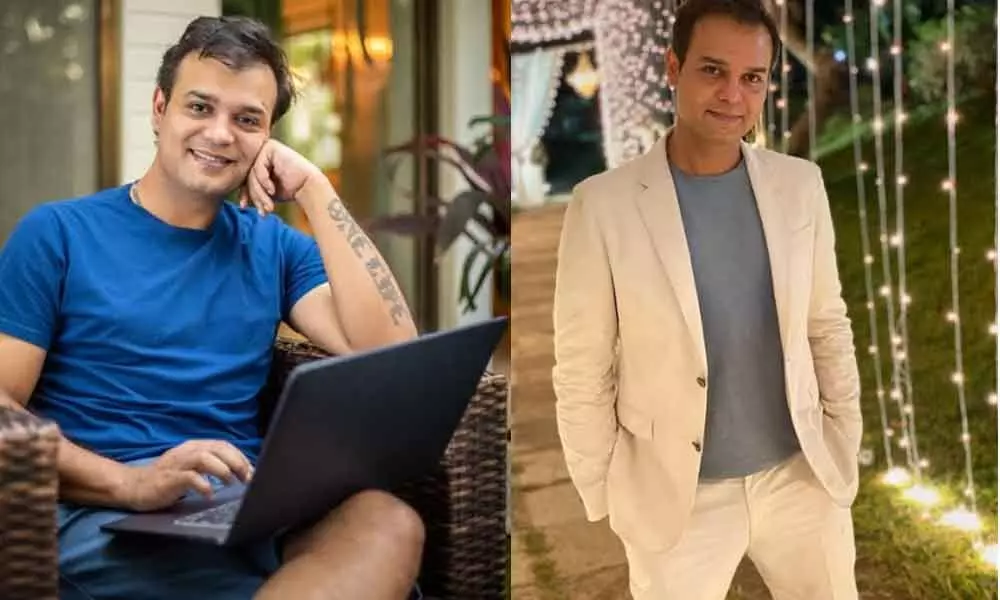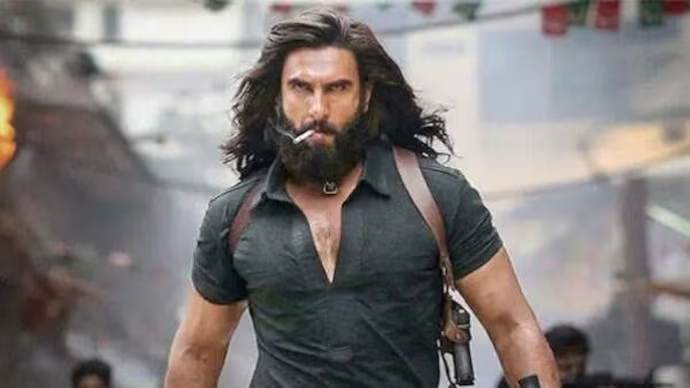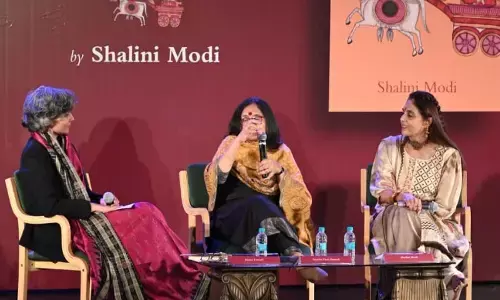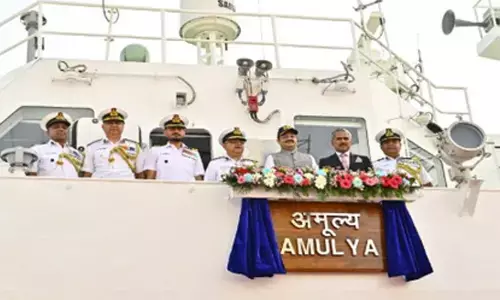Recreating ancient splendour

Siddharth Kumar Tewary,
He is a raconteur, a writer, creative producer and director who has been entertaining the audience on television for more than a decade.
He is a raconteur, a writer, creative producer and director who has been entertaining the audience on television for more than a decade. Siddharth Kumar Tewary is steeped in the world of mythology and history and also has to credit serials in different genres with arresting storylines. Through his powerful narratives, he has been taking the audience to the bygone era through his serials which are magnificent, grand and enrapturing. Backed with lot of research and fine detailing, Siddharth has been able to carve a niche for himself in this arena skilfully providing edutainment too. Mahabharat, Maha Kali- Anth hi Aarambh hai, Karmaphal Daata Shani, Suryaputra Karn, Ram Siya ke Luv Kush, Porus, Chandragupta Maurya, Radha Krishn (currently shown on television) are some from his oeuvre. Others include Ambar Dhara, Agle Janam Mohe Bitiya Hi Kijo, Navya, Dosti, Yaariyan, Manmarziyan to name some. Siddharth's Mahabharat (made in 2013) is having a second re-telecast on the small screen after the first in the lockdown.
RADHIKA RAJAMANI
You have been making serials revolving around mythology and history mostly though you started off with Ambar Dhara. How did you get interested in this? Were you exposed to mythology and history since childhood?
Like any other Indian child growing up in Calcutta in a typical middle class family where my father was a professor I watched mythology on television. I never thought then I would be making them. It was only when Star Plus called me and told me they liked my work the other stories I was telling at that point of time (Ambar Dhara, Navya, Manmarziyan to name a few) , the way I used to write my characters and they wanted to make Mahabharat and wanted me to interpret this epic for them. I didn't believe at the outset. Then when I started reading it, the journey in my life started. Then the idea of recreating a world, understanding it and creating your own interpretation of it because unless you understand you can really tell that began. I believed one needs to have one's own interpretation. I realised these are stories that a whole generation needs to know – who are we, where we came from, why are we the way are in an entertaining way – edutainment rather.
One read Amar Chitra Kathas during childhood. Children of today are not much into epics, mythology and history. Do you feel by bringing the rich heritage in an engaging visual format for the youngsters they are more likely to see them rather than read books or play games etc? This is a way of educating them about the past in an entertaining mode…
It took me five years to make Mahabharat. In that journey I read, learnt, questioned. People used to ask me how are you making Mahabharat as a young boy? (Siddharth still looks young). That somehow helped. I tried to think as a youth of today who would be questioning since they have a mind of their own. They want to understand things. These are stories to be told. So, one after the other, I started making them.
Yes, after Mahabharat you got into making serials on mythology and history...
These are subjects relevant to the whole family, they do not talk to just the women of the house. The whole family can sit and watch together – the older generation and the younger generation can see who we are, our roots and the stories that made us. The historicals are about inspiring people who gave their life for the country. Every time I had to recreate a new world. If I was making Mahabharat and later on Shani, I had to visualise it completely differently. There were huge creative challenges as to how to visualise that world, how to transport the viewers into a different era. I was not just creating; I was getting so much to learn from these stories which changed my life too. My beliefs were completely transformed thanks to our texts.
So, one can say Mahabharat was the triggering point to look further into mythology and history.
Yes, that was the first mythology we made. We had no experience but we wanted it to be a big one and made it. Everything fell into place and we made something we are really proud of. It has been number one.
Right now Mahabharat is topping the charts as it is being re-telecast. How do you feel? There is this timelessness of this epic. Do you think this timelessness is one of the reasons for its popularity or other factors are also responsible?
I am not the first person or the last person to make Mahabharat. These stories have been told over centuries. Over centuries there have been interpretations and people have been making it. It has to be made relevant to the times you are creating it. So, it becomes relevant. The interpretation is what made it classic and timeless. At the start we wanted it to be something to remember for a lifetime. It is still relevant even after seven years as it is being telecast the second time again after seven years. I feel nice and humbled now.
You are at ease doing mythology and history. You have done Karmaphaldaata Shani, Mahabharat, SuryaputraKarn, Ram Siyake Luv Kush, Mahakali- Anth hi Aarambh hai, RadhaKrishn (currently under production) to name a few along with Chakravartin Samrat Ashoka, Porus and Chandragupta Maurya. How do you choose these subjects?
There must be something new I should be able to tell. There should be a new learning for me and there should be something new which the viewers get to see. There should be a reason why we are making it- how to make it relevant to the times. Like for instance, in Kali, we see how Parvati, who has given life to the world had to become Kali. She is pushed to the brink when she turns into Kali and destroys. It makes me tell that story.
Making these serials is a challenge. People have certain mindsets and notions especially around the epics and mythological characters. How do you address this in terms of bringing new interpretations to the table?
There are challenges always. What happens with historicals and mythology is that people have plenty of pre-conceived notions. They always believe for example Krishna lived like this or Mahadev or any of the gods or any of the famous historical characters. When you are making them, it is important to read up with the viewers' expectations. You have to accept the expectations. You have to lead the viewers' preconceived notion then you can exceed their expectations. That is the only way you can go about it. In Mahabharat I cast Saurabh Raj Jain as Krishna. A lot of people told me he is not dark skinned he will not work, he is not the right boy but I believed that Saurabh had the right expressions, he is a good performer and people watch him more and more, they will love him.
Saurabh really got under the skin of the character...
Yeah. I always believe that all the things come together. You definitely have to meet the viewers' expectations. It is not that anybody has known Krishna or met them in their lives, it is just that it has come through an idea, calendar art, stories that they have heard or their own imagination. It is tough to match the whole country's imagination because it is quite diverse. There are many stories which are distinctly different in every part of the country. So, somewhere you have to keep that in mind and go in that direction.
What is the kind of research done and how do you find writers to execute your vision? I think you have advisors like Devdutt Pattnaik and many more…
There is a way we have been working over the years. Research is important before we start working on something. We have had people for Mahabharat like Devdutt Pattnaik or Kannan (Phd) from Chennai who have the knowledge. It will take me a lifetime to read. They will give us the different points. In India there are different books on the same subject. It is tough to follow one or not follow another. Stories keep changing in different parts of India.
There are many interpretations...
Yes there are definitely. You have to listen to them all, read them all and try to find out which is the most popular one because you cannot upset people's sentiments as they are touchy. So you need regular researchers to give you different stories in different parts of the country. There are lots of discussions till the point about what we should be finally made. From there I have a certain team of writers who have worked with me in different shows. So I connect with them, we all sit together, discuss and we write. So, I also wrote the Mahabharat with my writing team. The writers I have for different shows are all passionate. I don't get people on board who don't have basic knowledge and who are not willing to give it that much time to read and understand mythology. If people don't understand Indian mythology, they cannot write it. If they are not excited by history it is tough for them to get on board to create. For me when we make something and people appreciate it, I feel happy that people have liked my work so far.
Swastik Productions was set up by you and your brother Rahul is also involved. This Swastik symbol is one of divinity and spirituality. Did you choose it as it has such ancient roots?
There was no such thought. Years before Swastik was established and I was an employee with Sony Entertainment Television I wondered what I should do. I wanted to do something which will stay with me for life. Four-five years later when I was starting my journey I thought I should call it Swastik. A few years later I called Rahul from Australia where he was settled. Another new company we started is called One life studios. That was also a thought which came to me as I realised we all have one life eventually. I will remember this life. So I have to live this life to the fullest.
You also built the studios because your productions are on such a large scale that involves majestic and artistic sets. Is it also because that you set up your shooting space?
Over the years at Onelife I realised felt we need to grow as a company and for that it needs to extend and grow in such a way that it is organically stable and connects to our core work. We wanted to build studio facilities and our own larger than life sets. If we build then we can use this infrastructure as we go ahead and not compromise on the vision. So studio facilities are built over 25 acres of land have 19-20 shooting floors, and other areas for visual sets.
So, all this is at Umargaon?
Yes, it is two and a half hours from Mumbai. It's got other locations because for historicals and mythologicals we need to change locations close by. Since there are space constraints in Mumbai we had to move here. Slowly we built everything.
You are setting new highs as far as sets are concerned. Their opulence and grandeur is magnificent enough to transport one to that era as well as overawe anyone. What are your reference points? What kind of research goes into developing this? How difficult/challenging is it to conceptualise and execute them according to your vision?
This is a valid question. We look at temple architecture – there are many temples like Meenakshi temple at Madurai, the Sun temple, read what it is in books, and refer to designs . What is important is the perception of that world. We look at wooden architecture, calendar art – the images of Raja Ravi Varma – these also give a dimension.
You went into 19th century art also to get an idea of all this...
After I get to know what the reference points are, what kind of clothes they wore I would have to recreate that world, look at popular perception and reality and what is this work for. Television is a mass platform. We recreate that world. Every detail you see on telelvision is recreated for the series - from the sets, costumes, jewellery.
Your productions of serials is lavish and top notch in terms of not just sets but also the costumes, jewellery and other artefacts. The splendour is mind-boggling, especially the way you create the grandeur. How do you achieve this? Sometimes what you see in text doesn't get translated into paper or an image. How do you strike this balance in getting a perfect symmetry and synergy?
I don't know. I honestly dont think so much. Whatever comes to my mind naturally I would sit down with the team and work. If I want to tell a story to others it should be interesting and exciting to me first. If it is so then it will interest others. This is what I believe in; this is what I have always been doing. If I believe it is fine then we shoot it. I am only trying to better myself with each project. That is the only way to grow. You learn from improving yourself. I am not trying to compete or look at anybody else.
Swastik Productions is prolific in its content. How do you achieve this and yet ensure a high standard?
Thank you for this. We believe in good content. I have been watching television for 25 years. I always believe that this audio-visual medium has to be of good standard and quality. We are trying to keep our content at a global level. It is important that we give people quality stuff and that is what we try to always do. There is no compromise. We feel we should be honest and do it well enough.
Your casting is almost spot-on. How do you manage to find actors? Most of them in Mahabharat or Radhakrishn are very young and very fluid in portraying these roles whether they are mythological or historical?
Good that you liked my casting. While working on the story and developing it I get a kind of visual sense of what person I want in this role. Thanks to my casting team which does auditions all over India and from that if I like someone I retest and retest them. I work with people who really want to play that role. That's the most important thing. I see why the actors want to play this role, what they want to give to it. These are not characters that you can come out of your house and play them on the sets. You will have to invest time, energy and effort. Be it in Radhakrishn, Porus or Mahabharat actors have invested time on preparing. For Mahabharat, before the shoot began for more than a year the actors went through learning body language, posture, diction, horse riding lessons, action lessons. We create a world for them to get into. As actors it is important. I can advise on the character and they have to perform once they get on to the floor.
I think you do workshops and reading sessions to look at acting in a very professional way
Yes. Six-eight months before shooting we put the actors through all kinds of training because they are entering a new world. Workshops of all kinds are arranged - action, diction, acting. There are character discussions and everything which is needed. I try to comfort the actor from all sides. It is important that the actor should be willing to give - all be it Sourabh, Sumedh, Lakshya, Himanshu, Shipra, Pooja, Shaheer – all the actors have been my colleagues. They looked like those characters as they believed in them.
I think they lived those characters for that many months or years...
Yes. I try to get the best out of my actors. I try to make them comfortable. They are all great actors. Somehow I got people who were hungry for their roles.
You also developed a high level of visual effects which is evident in these mythologicals and historical. How does technology help you in your story telling?
Technology is a big boon for us. We recreate a world which is not possible without visual effects coming in. We can tell whatever we want to as the power of technology gives me. That's how we started One Life – the company which does visual effects not just for us but for other shows too. We have done for movies and digital shows too. Primarily it started with the thought that we control the output and give it to someone. That's how One Life came into being as we needed to grow and give better content. It helps us in telling what we want to and imagined.
How do you feel now that your shows have gone international and catering to a much larger audience especially with Porus?
It has been an interesting journey because I always believe we need to create value for our company. We feel as a company we should pick up partners. As partners our products will be sold in a better way. The distribution company started and we started going to different markets all across the world. Just like us, there were other people willing to sell their content. The company is not jut selling our content but also others' content. We got Porus into Japan on Hulu (premier OTT platform). It's done well.
Are you exploring animation now?
We are working on the animation series.
How do you and your brother Rahul operate? Do you have distinct areas to look into and you both are involved creatively?
Rahul has a finance background and he basically runs the company. I do the creative aspects. I have my wife, who is a writer and I use her mind a lot. There is team work involved.
You registered Swastik as a company. Was it because you wanted to follow a structured approach in the work that you do?
If you start a company it has to be registered. This was registered 12 years back. I started off by wanting to tell a story and direct. I am luckily still doing that. One thing led to the other. We started a company. That is where it really helped us over the years. Now we can do what we believe in. We can now go out and tell a story we believe in. I don't feel as a corporate house. I feel we are one big Swastik family. We have tremendous personal touch with all our people. Our team has been there with us for years.
You all share a very warm bond...
We have grown together. Business came to a halt with the lockdown. Even with the lockdown I have not fired anybody. Everybody is still working with us. I wish we are able to continue as we are going. I wish we are always maintaining the family relationship.
What's next on the anvil?
I will announce later. We are working on the digital space.
With such a hectic schedule do you find time to unwind? If so, how do you do it?
I am quite blessed with a great team. This lockdown has given me a lot of time. I unwind with my family. There have been some realisations in this period. You need to go step by step. Be with important people who matter to you in your life.
What are your interests besides making these serials?
I play tennis as I love the sport. I am a sports person completely. I watch tennis matches.
You must have read a lot for doing these historicals...
Laughs. Yeah but I am not a voracious reader. I read if I have to tell a story of a world at some point of time. I need to do so.
How would you describe your journey?
The fact that I am able to create – that's special. I feel humbled. I will keep working hard and keep giving what I am here for. This has given me tremendous love and happiness.

















